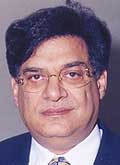The Deming journey
27 November 2004
 Chennai: "The Deming process is like getting a doctorate. In PhD there is no syllabus. One has to choose an area that has not been researched previously by somebody else and come out with your own findings," says Dr Surinder Kapur, chairman and managing director, Sona Koyo Steering Systems Limited, a postgraduate in mechanical engineering from Michigan State University, USA, with a doctorate in fluid dynamics.
Chennai: "The Deming process is like getting a doctorate. In PhD there is no syllabus. One has to choose an area that has not been researched previously by somebody else and come out with your own findings," says Dr Surinder Kapur, chairman and managing director, Sona Koyo Steering Systems Limited, a postgraduate in mechanical engineering from Michigan State University, USA, with a doctorate in fluid dynamics.
The Rs286-crore-turnover company won the prestigious Deming quality medal last year from the Union of Japanese Scientists and Engineers (JUSE). A great admirer of Toyota Production System (TPS), Dr Kapur yearns for Sona Koyo to be able to resemble the Japanese auto company. But he knows that the journey will be a long one. Here he talks about his company's journey into the rigorous world of the Deming quality processes and the efforts required to keep improving further from there. Excerpts.
When did the company start practising the Deming quality process? What had it been practising earlier?
At Sona Koyo, quality was built into process right from its inception. Machines were arranged into a cellular layout (product layout). Quality checks were made part of the process and were done by the operators. In 1999-2002, when our net profit came down to a record low, we were determined to do something about it.
There was a marked change in the quality process when Toyota Production Systems' (TPS) expert ,M.Tanaka from Koyo Seiko, Japan, started guiding us in the early '90s. Many pokayoke (fool proofing) systems were installed to avoid operator mistakes. That is when we started gaining a real understanding of TPS.
Problem solving was made a necessary process in production management. We learnt how to become capable of supplying products just-in-time to customers. Our quality system was strengthened in line with ISO-9002 in 1994.
What was the manufacturing efficiency before you started practising the total quality management (TQM) process seriously?
